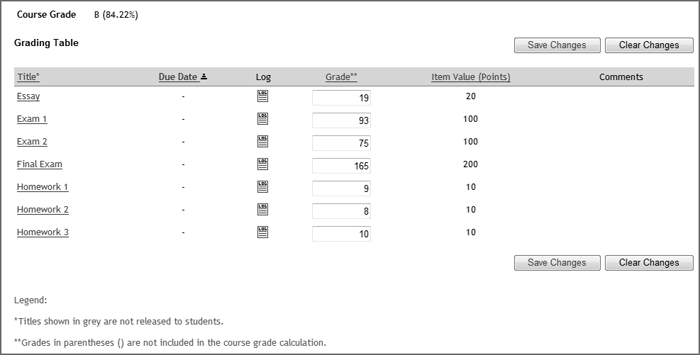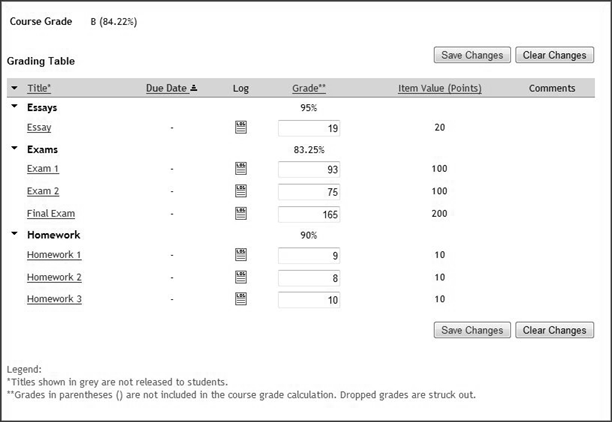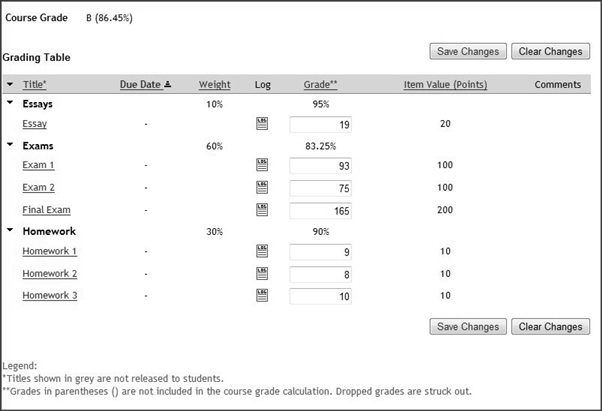ARCHIVED: In Oncourse Gradebook, how do categories and weighting affect grade calculation for points gradebooks?
The way your gradebook calculates course grades depends on how you have set it up; see ARCHIVED: Using categories and weighted grades in Gradebook. The following examples illustrate how the different choices in Gradebook Setup will affect how students' course grades are calculated in a points gradebook.
On this page:
- Displaying grades as points with no categories and no weighting
- Displaying grades as points with simple categories
- Displaying grades as points with weighted categories
Displaying grades as points with no categories and no weighting
In this example, the instructor has set up the gradebook with no categories.

The course grade is calculated as follows:
| Title | Grade (Points) | Item value |
|---|---|---|
| Essay | 19 | 20 |
| Exam 1 | 93 | 100 |
| Exam 2 | 75 | 100 |
| Final Exam | 165 | 200 |
| Homework 1 | 9 | 10 |
| Homework 2 | 8 | 10 |
| Homework 3 | 10 | 10 |
| Total | 379 | 450 |
Total: 379 points
Course grade: 84.22% (379/450 * 100)
Displaying grades as points with simple categories
In this example, the instructor has set up the gradebook with simple, unweighted categories.

Notice that the percentage for each category is displayed. These percentages do not affect the grade calculation.
The course grade is calculated as follows:
| Category | Title | Grade (Points) | Item value |
|---|---|---|---|
| Essays | Essay | 19 | 20 |
| Exams | Exam 1 | 93 | 100 |
| Exam 2 | 75 | 100 | |
| Final Exam | 165 | 200 | |
| Homework | Homework 1 | 9 | 10 |
| Homework 2 | 8 | 10 | |
| Homework 3 | 10 | 10 | |
| Total | 379 | 450 |
Total: 379 points
Course grade: 84.22% (379/450 * 100)
Displaying grades as points with weighted categories
In this example, the instructor has set up the gradebook with weighted categories.

Category Essays (10% weight)
| Title | Grade (Points) | Item value |
|---|---|---|
| Essay 1 | 19 | 20 |
| Total | 19 | 20 |
Total (Essays): 95% (19/20 * 100)
Category Exams (60% weight)
Note that in the Exams category, the items have different point values (proportional weighting). Items with a higher point value have a greater influence on the grade (e.g., the final exam is worth twice as much as Exam 1).
| Title | Grade (Points) | Item value |
|---|---|---|
| Exam 1 | 93 | 100 |
| Exam 2 | 75 | 100 |
| Final Exam | 165 | 200 |
| Total | 333 | 400 |
Total (Exams): 83.25% (333/400 * 100)
Category Homework (30% weight)
Items in the Homework category all have the same point value (equal weighting) and influence the grade equally.
| Title | Grade (Points) | Item value |
|---|---|---|
| Homework 1 | 9 | 10 |
| Homework 2 | 8 | 10 |
| Homework 3 | 10 | 10 |
| Total | 27 | 30 |
Total (Homework): 90% (27/30 * 100)
| Category | Weight | Contribution to grade |
|---|---|---|
| Essays | 10 | 9.5% (10%*95%) |
| Exams | 60 | 49.95% (60%*83.25%) |
| Homework | 30 | 27% (30%*90%) |
| Total | 86.45% (9.5%+49.95%+27%) |
Course Grade: 86.45%
In the unweighted gradebook setup illustrated in the first two scenarios, the essay was worth 20 out of a total of 450 points, or about 4% of the final grade; the exams were worth 400 out of a total of 450 points, or about 89% of the final grade; and the homework was worth 30 out of 450 points, or about 7% of the final grade. However, in the scenario with weighted categories, the essay is set to 10% of the final grade, the exams to 60%, and the homework to 30%. Since this hypothetical student did better on the homework and essay than on the exams, the final grade is higher than it would be with the same scores and unweighted categories.
This is document axwr in the Knowledge Base.
Last modified on 2018-01-18 16:03:57.